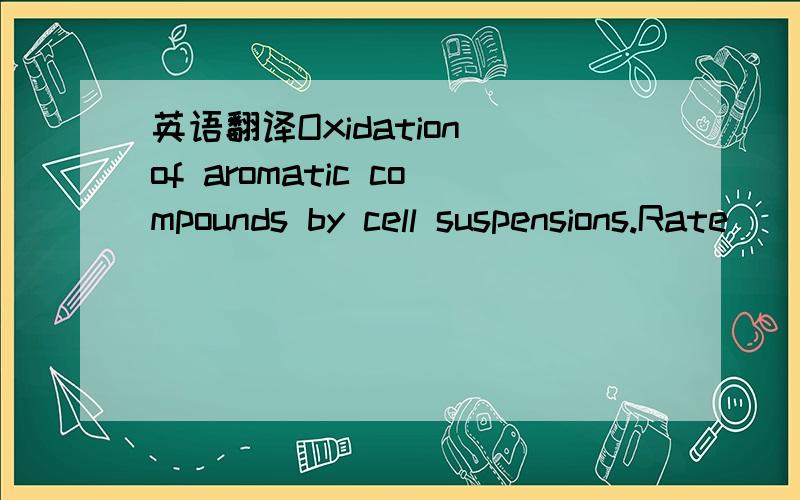英语翻译Oxidation of aromatic compounds by cell suspensions.Rate
来源:学生作业帮 编辑:大师作文网作业帮 分类:英语作业 时间:2024/11/11 08:47:44
英语翻译
Oxidation of aromatic compounds by cell suspensions.
Rates of respiration by washed cells increased with increasing
concentrations of o-DCB to 10-4 M.Washed suspensions
of o-DCB-grown cells rapidly oxidized o-DCB,chlorobenzene,
and all of the substituted catechols (Table 1).
Chlorobenzene-grown cells gave similar oxidation rates.
Acetate-grown cells oxidized o-DCB at much lower rates
and did not oxidize catechols or phenols.However,they
oxidized o-DCB dihydrodiol at rates similar to those obtained
with induced cells.
Chloride release.Chloride was released rapidly from o-
DCB,chlorobenzene,3,4-dichlorocatechol,3-chlorocatechol,
and 4-chlorocatechol (Table 2).Chloride was not
released from any of the chlorophenols except 3,4-dichlorophenol.
The stoichiometry was less than those predicted for
the dichlorocatechols and o-DCB dihydrodiol.Cells grown
on acetate or yeast extract (data not shown) did not release
chloride from the aromatic substrates.
Incorporation of radiolabeled o-DCB.Washed suspensions
of o-DCB-grown cells mineralized and incorporated the
radiolabel from [o-U-_4C]DCB (Table 3).The volatility of thesubstrate resulted in some loss of the radiolabel; however,
40% of the initial radioactivity was obtained as C02,and the
remainder was distributed between the cells and the culture
filtrate.
The recovery of radioactivity in the filtrate suggested the
accumulation of metabolic intermediates.When a portion of
the filtrate was analyzed by HPLC,two radioactive products
were detected.One of these products cochromatographed
with o-DCB dihydrodiol (3.2 min).The other product,which
was more polar,could not be identified.Radioactive products
were not detected in the formaldehyde-killed control
samples.
请不要用一些所谓的翻译工具来浪费您宝贵的时间,我需要达人。
Oxidation of aromatic compounds by cell suspensions.
Rates of respiration by washed cells increased with increasing
concentrations of o-DCB to 10-4 M.Washed suspensions
of o-DCB-grown cells rapidly oxidized o-DCB,chlorobenzene,
and all of the substituted catechols (Table 1).
Chlorobenzene-grown cells gave similar oxidation rates.
Acetate-grown cells oxidized o-DCB at much lower rates
and did not oxidize catechols or phenols.However,they
oxidized o-DCB dihydrodiol at rates similar to those obtained
with induced cells.
Chloride release.Chloride was released rapidly from o-
DCB,chlorobenzene,3,4-dichlorocatechol,3-chlorocatechol,
and 4-chlorocatechol (Table 2).Chloride was not
released from any of the chlorophenols except 3,4-dichlorophenol.
The stoichiometry was less than those predicted for
the dichlorocatechols and o-DCB dihydrodiol.Cells grown
on acetate or yeast extract (data not shown) did not release
chloride from the aromatic substrates.
Incorporation of radiolabeled o-DCB.Washed suspensions
of o-DCB-grown cells mineralized and incorporated the
radiolabel from [o-U-_4C]DCB (Table 3).The volatility of thesubstrate resulted in some loss of the radiolabel; however,
40% of the initial radioactivity was obtained as C02,and the
remainder was distributed between the cells and the culture
filtrate.
The recovery of radioactivity in the filtrate suggested the
accumulation of metabolic intermediates.When a portion of
the filtrate was analyzed by HPLC,two radioactive products
were detected.One of these products cochromatographed
with o-DCB dihydrodiol (3.2 min).The other product,which
was more polar,could not be identified.Radioactive products
were not detected in the formaldehyde-killed control
samples.
请不要用一些所谓的翻译工具来浪费您宝贵的时间,我需要达人。

饥渴欲望,强烈呼求加分HOHO...
细胞悬浮液中芳香族组分的氧化.
(滤洗后?不敢确定)细胞的呼吸速率随着邻二氯苯浓度的增加可以升至10.4每分钟,邻二氯苯条件下生长的细胞滤洗后悬浮物能迅速氧化邻二氯苯,氯化苯及所有取代的苯磷二酚(见表1 ),氯苯条件下生长的细胞也能达到同样的氧化速率,醋醋酸盐条件下生长的细胞氧化邻二氯苯的速率就要低得多,而且不能氧化苯磷二酚类或酚类物质,然而它们氧化邻氯苯二氢二醇的速率可以跟诱导细胞相似.
氯化物分泌(产生)
氯化物能够迅速的由二氯苯、氯化苯、3,4 -苯磷二酚、3-苯磷二酚、4-苯磷二酚(见表2),除了3,4 -苯磷二酚,氯化物没有在任何一种苯磷二酚类物质中产生,二氢二醇邻二氯苯及苯磷二酚的计量比预估的要少,醋酸盐或酵母提取物条件下生长的细胞(无数据显示)就不会通过芳香族类培养基产生氯化物.
邻二氯苯的放射性同位素示踪组成
邻二氯苯条件下生长的细胞细胞由[邻U型_4C ]二氯苯矿化和组合其放射性同位素示踪(见表3),培养基的组分含量变化也对放射性同位素示踪产生影响,然而40%的初始放射量由二氧化碳而得,其余的来自于细胞培养物的滤液.
细胞培养物滤液当中的放射量回复增加兆示了中间代谢物含量的增加,当用高效液相色谱法分析部分滤液时,可以检测到两个放射性组分,其中之一是以二氢二醇邻二氯苯参照共同色谱分析而得(3.2分钟),另一组分极性更强,无法鉴别,在用甲醛消毒杀菌的样品当中未能检测到放射性组分.
细胞悬浮液中芳香族组分的氧化.
(滤洗后?不敢确定)细胞的呼吸速率随着邻二氯苯浓度的增加可以升至10.4每分钟,邻二氯苯条件下生长的细胞滤洗后悬浮物能迅速氧化邻二氯苯,氯化苯及所有取代的苯磷二酚(见表1 ),氯苯条件下生长的细胞也能达到同样的氧化速率,醋醋酸盐条件下生长的细胞氧化邻二氯苯的速率就要低得多,而且不能氧化苯磷二酚类或酚类物质,然而它们氧化邻氯苯二氢二醇的速率可以跟诱导细胞相似.
氯化物分泌(产生)
氯化物能够迅速的由二氯苯、氯化苯、3,4 -苯磷二酚、3-苯磷二酚、4-苯磷二酚(见表2),除了3,4 -苯磷二酚,氯化物没有在任何一种苯磷二酚类物质中产生,二氢二醇邻二氯苯及苯磷二酚的计量比预估的要少,醋酸盐或酵母提取物条件下生长的细胞(无数据显示)就不会通过芳香族类培养基产生氯化物.
邻二氯苯的放射性同位素示踪组成
邻二氯苯条件下生长的细胞细胞由[邻U型_4C ]二氯苯矿化和组合其放射性同位素示踪(见表3),培养基的组分含量变化也对放射性同位素示踪产生影响,然而40%的初始放射量由二氧化碳而得,其余的来自于细胞培养物的滤液.
细胞培养物滤液当中的放射量回复增加兆示了中间代谢物含量的增加,当用高效液相色谱法分析部分滤液时,可以检测到两个放射性组分,其中之一是以二氢二醇邻二氯苯参照共同色谱分析而得(3.2分钟),另一组分极性更强,无法鉴别,在用甲醛消毒杀菌的样品当中未能检测到放射性组分.
英语翻译The rate of saving multiplied by the marginalutility of
英语翻译AbstractPurpose The oxidation of ammonium (NH4+) to nitr
英语翻译3.4.Elucidating the possible oxidation of Sn2+ within Sn
英语翻译Evaluation of the cytotoxicity of these compounds employ
英语翻译Structure Determination of Organic Compounds:Tables of S
英语翻译Toxic effects of fluoride compounds have been described
by a rate of five to one
英语翻译A study of cell phones by the Swedish Radiation Protecti
英语翻译Model development of the oxidation of the dioxin-like co
英语翻译We will recoup ourselves by the levy of a general rate;f
英语翻译Alloys are compounds consisting of more than one metal.A
英语翻译RNA recognition by the embryonic cell fatedeterminant an